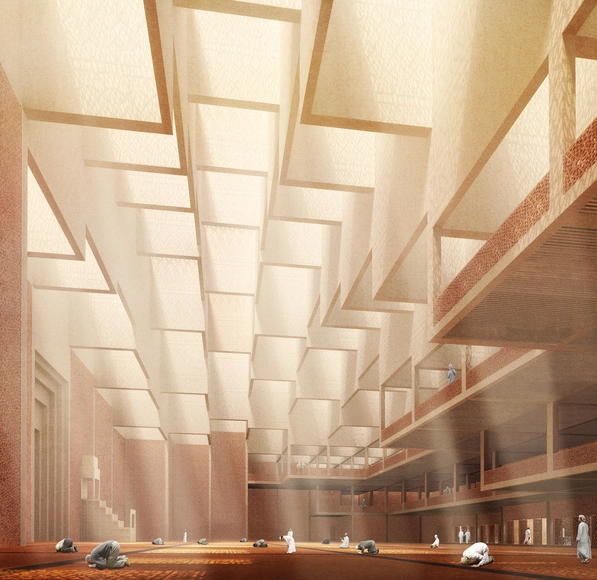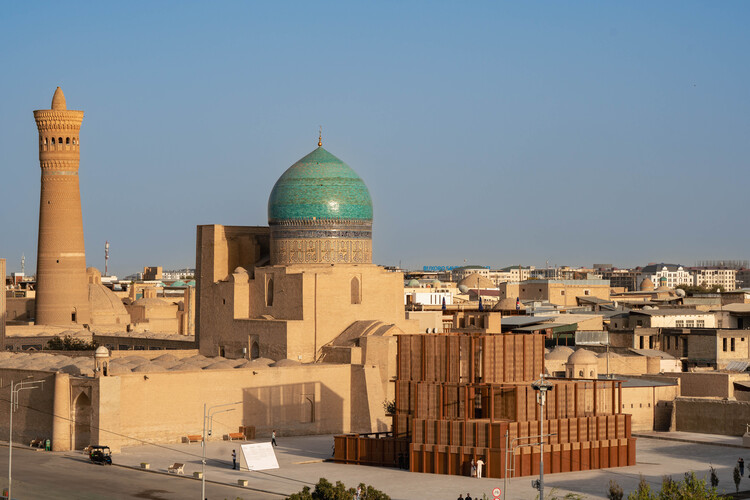In April 2024, the Diriyah Biennale Foundation announced the AlMusalla Prize, an international architecture competition focused on designing a musalla: a flexible space for prayer and reflection accessible to people of all faiths. The winning project, designed by EAST Architecture Studio in collaboration with artist Rayyane Tabet and engineering firm AKT II, is a modular structure built with materials derived from local date palm waste, including fronds and fibers, and inspired by regional weaving traditions. Installed in the Western Hajj Terminal of King Abdulaziz International Airport in Jeddah, Saudi Arabia, the musalla served for four months during the Islamic Arts Biennale as a space for prayer, welcoming both Muslim and non-Muslim visitors. Conceived to be dismantled and reassembled, the structure was recently relocated to Uzbekistan for the inaugural Bukhara Biennial 2025.
Islam: The Latest Architecture and News
From Saudi Arabia to Uzbekistan: AlMusalla Pavilion Reinstalled for the Inaugural Bukhara Biennial 2025
The Symbolic Use of Color in Islamic Architecture

The Islamic Architecture style has a diverse history, spanning over a millennium, stretching from Western Africa to Europe to Eastern Asia. Beginning in early 7th century Arabia, this form of architecture emerged with the rise of the Islamic civilization. In fact, Al Masjid Al Nabawi, the first Mosque to ever be constructed was built in 622, in Medina, Saudi Arabia. Moreover, early Islamic architecture was influenced by the pre-existing styles around the region, such as Roman, Byzantine, and Persian qualities.
Today, Islamic architecture is known for its acute attention to detail, craftsmanship, and its spiritual symbolism. Furthermore, as color plays an essential role in architecture, influencing the emotional experience of the space, different colors have been utilized over the years in Islamic Architecture to evoke certain meanings. In Islamic Architecture, colors hold significant spiritual symbolism, reflecting the values and beliefs of the Islamic faith. Four core colors, Green, Blue, Gold, and White, are each used to convey various cultural, religious, and symbolic meanings.
Read on to discover the use of these colors in various Islamic architectural icons around the world.
Central Mosque of Pristina Competition Entry / Dürig AG

Another noteworthy proposal for the Central Mosque of Pristina in Kosovo; this time, from Zurich-based architecture firm, Dürig AG. They envision the new mosque as an interplay between the individual and the community. "Mosques are places of worship for the Islamic community where the single believer joins a larger body for the ceremonial act of worship and prayer." Singular elements combine to make a larger, more meaningful, whole. "Thus, [our proposal] stands as a materialized representation for the individual within the Islamic community of Kosovo."
Natural daylight softly descends through the modulated plenum, creating a uniform prayer hall. Perforations throughout the facade and interior wooden panels enable a visual transparency that, Dürig AG expects, should spawn a dialogue between individuals inside the mosque and pedestrians in the city.

















